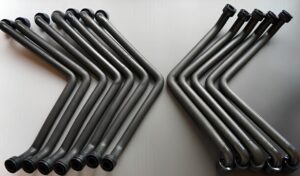EPDM (Ethylene Propylene Diene Monomer) material is a versatile synthetic rubber compound renowned for its wide range of applications and exceptional properties. Understanding its uses and benefits can unlock a plethora of opportunities across various industries. Let’s delve into the ultimate guide to EPDM material, exploring its composition, history, advantages, applications, environmental impact, innovations, and more.

Introduction
EPDM material, short for Ethylene Propylene Diene Monomer, is a synthetic rubber compound widely used across numerous industries for its exceptional properties and versatility. As we embark on this journey to uncover the power of EPDM material, it’s essential to grasp the fundamental concepts behind its composition, history, and applications.
What is EPDM Material?
EPDM material, also known as ethylene propylene rubber, is a synthetic elastomer derived from ethylene, propylene, and a diene monomer. Its unique molecular structure contributes to its outstanding properties, including weather resistance, durability, and flexibility. EPDM material is commonly produced in the form of sheets, rolls, and molded parts, making it suitable for various applications in construction, automotive, electrical, and other industries.
History of EPDM Material
The history of EPDM material can be traced back to the mid-20th century, driven by the need for a more reliable and versatile material than natural rubber:
- 1950s Development: EPDM was developed by DuPont in the 1950s. Natural rubber had been the go-to material for many applications, but it couldn’t keep up with the growing global demand. EPDM offered a synthetic alternative with several advantages.
- 1960s Introduction to Roofing: In the early 1960s, EPDM began to be used as a roofing membrane. Its durability, weather resistance, and waterproofing abilities made it a strong candidate for this demanding application.
- 1970s Rise in Popularity: The 1970s saw a surge in the popularity of EPDM roofing. The oil crisis of that era led to a rise in asphalt prices and a decline in asphalt quality. This created an opportunity for EPDM, which offered a more reliable and long-lasting roofing solution.
- 1980s Domination of Single-Ply Roofing: By the 1980s, EPDM had become the dominant material in the single-ply roofing market. Advancements like the development of seam tapes in the 1980s to replace messy liquid adhesives further improved the installation efficiency and performance of EPDM roofs.
- Continued Innovation: While the core EPDM formulation has remained relatively constant, innovation continues in related areas. This includes advancements in accessories like self-adhering components and ergonomic installation tools for improved efficiency and quality. There’s also ongoing exploration of incorporating fillers and nanomaterials into EPDM to potentially enhance specific properties. The EPDM industry is also showing a growing focus on sustainable manufacturing practices.
EPDM’s success story lies in its ability to address the limitations of natural rubber and provide a durable, cost-effective, and versatile material for various applications. While the core material might see incremental changes, ongoing advancements aim to make EPDM an even more sustainable and efficient choice in the construction and manufacturing industries.
Advantages of EPDM Material
Here’s a breakdown of its key strengths:
- Durability: EPDM shines with exceptional resistance to wear and tear, weathering, ozone, UV exposure, and many chemicals. This makes it ideal for long-lasting outdoor applications like roofing membranes and pond liners.
- Weather Resistance: EPDM thrives in extreme temperatures, ranging from -50°C to +150°C, making it suitable for both cold and hot environments. Its resistance to UV rays and ozone allows it to withstand harsh sunlight without degrading.
- Waterproofing: One of the most water-resistant rubber materials, EPDM excels in applications requiring an impermeable barrier. This makes it a top choice for roofing and pond liner applications.
- Cost-Effectiveness: Compared to other roofing or sealing materials, EPDM is generally less expensive. Additionally, its ease of installation can contribute to lower overall project costs.
- Flexibility: EPDM offers good flexibility, allowing it to form around irregular shapes and accommodate movement without cracking. This makes it useful for gaskets and seals.
- Safety: EPDM is non-toxic and safe for use around children and pets, making it a good choice for applications like pond liners or playground equipment.
- Recyclable: EPDM can be recycled after its lifespan, reducing landfill waste and promoting resource conservation.
- Low Maintenance: EPDM roofs require minimal maintenance throughout their lifespan. They resist moss, algae growth, and degradation from UV rays and ozone, eliminating the need for harsh chemicals or frequent cleaning.
- Minimal Environmental Impact: EPDM’s chemical composition doesn’t leach into rainwater, ensuring clean rainwater runoff suitable for potential harvesting with proper filtration. Life cycle studies have also shown EPDM roofing systems to have a lower environmental impact compared to other roofing materials.
These advantages make EPDM a versatile and cost-effective material for a wide range of applications in construction, automotive, industrial, and various other sectors.
Applications of EPDM Material
EPDM’s well-rounded set of properties translates into a diverse range of applications across numerous industries. Here’s a glimpse into some of its most common uses:
Construction:
- Roofing Membranes: EPDM stands out as a popular choice for roofing due to its exceptional durability, weather resistance, and waterproofing abilities. It creates long-lasting, low-maintenance roofs suitable for various climates.
- Sealants: EPDM finds use in sealants that ensure watertightness around windows, doors, and other building components, contributing to a building’s overall envelope integrity.
- Garage Door Seals: EPDM’s flexibility and weather resistance make it ideal for garage door seals, keeping out dust, moisture, and drafts.
- Pond Liners: EPDM’s impressive waterproofing ability makes it a go-to material for pond liners, keeping decorative ponds contained and preventing leaks.
Automotive:
- Window and Door Seals: Under the hood of your car, EPDM likely plays a role in various parts. Its flexibility and weather resistance make it ideal for window and door seals, keeping out moisture and ensuring a quiet ride.
- Hoses: EPDM’s flexibility and chemical resistance make it suitable for hoses that transport fluids like coolant or antifreeze within the car’s engine compartment.
- Belts: EPDM belts might be used to drive engine components like the alternator or power steering pump.
Industrial:
- Gaskets: EPDM’s strength and ability to form a tight seal make it a reliable material for gaskets, creating leak-proof connections between various industrial equipment components.
- O-rings: EPDM’s elasticity and compression resistance make it well-suited for O-rings, which provide a tight seal in pressurized systems like hydraulic lines.
- Grommets: EPDM grommets protect cables and wires as they pass through panels or enclosures, preventing abrasion and ensuring electrical safety.
- Electrical Insulation: EPDM offers good electrical insulation properties, making it suitable for insulating wires and electrical components.
Other Applications:
EPDM’s versatility extends beyond these core applications, finding uses in:
- Appliance hoses: Washing machine hoses or refrigerator water dispenser lines might be made of EPDM.
- Footwear components: EPDM contributes to waterproofing and flexibility in boots or shoes.
- Medical tubing: Some low-risk medical equipment might utilize EPDM tubing.
- Roofing ponds: Flat roof applications can benefit from EPDM’s waterproofing abilities to create a functional roof garden.
EPDM’s affordability, durability, and weather resistance make it a popular choice across many industries, offering a reliable and versatile material for various sealing, waterproofing, and insulation needs.
Environmental Impact of EPDM Material
EPDM boasts several environmental advantages throughout its lifecycle, making it a more sustainable choice compared to some other materials. Here’s a breakdown of its eco-friendly attributes:
- Recyclable: A major benefit of EPDM is its 100% recyclability after its useful life. This reduces landfill waste and promotes resource conservation. An increasing trend is the use of recycled tires as source material for EPDM production, further closing the loop.
- Durable: EPDM membranes for roofs can last for up to 50 years or even longer. This extended lifespan translates to less frequent replacements, reducing overall material consumption and environmental impact. There’s less waste generated from old roofs needing replacement, and fewer resources required to produce new ones.
- Low Maintenance: EPDM roofs require minimal maintenance throughout their lifespan. They resist moss, algae growth, and degradation from UV rays and ozone. This eliminates the need for harsh chemicals or frequent cleaning procedures that can pollute the environment. Less cleaning means less water usage and avoids potential environmental hazards from cleaning agents.
- Non-Polluting Rainwater: EPDM’s chemical composition doesn’t leach into rainwater that comes in contact with the material. This ensures that rainwater runoff from EPDM roofs remains clean and suitable for potential harvesting with proper filtration. Clean rainwater runoff can be a valuable resource for irrigation or other non-potable uses, reducing reliance on treated water.
- Life Cycle Assessment Studies: Studies like the 2010 Life Cycle Inventory and Assessment (LCA) have shown that EPDM roofing systems have a lower environmental impact compared to other roofing materials in terms of global warming potential, acidification, and smog generation. This means EPDM produces fewer greenhouse gasses and other pollutants during its production, use, and disposal compared to some alternatives.
Overall, EPDM’s recyclability, durability, low maintenance requirements, and minimal impact on rainwater contribute to a more sustainable building and construction process. It offers a balance of performance and environmental responsibility.
Innovations and Future Trends
EPDM, while a well-established material, continues to see innovation in how it’s used, manufactured, and potentially enhanced for future applications. Here’s a look at some key trends:
- Focus on Sustainability: The EPDM industry is placing a growing emphasis on environmentally friendly practices throughout the material’s lifecycle. This could involve:
- Increased Use of Recycled Content: Incorporating more recycled materials into EPDM production reduces reliance on virgin resources and lessens landfill waste.
- Energy-Efficient Manufacturing: Optimizing EPDM manufacturing processes to reduce energy consumption lowers the environmental impact associated with production.
- Bio-Based Alternatives for Raw Materials: Research into bio-based ingredients that could partially replace petroleum-derived components in EPDM production is ongoing.
- Advancements in Fillers and Nanocomposites: Researchers are exploring the potential of incorporating various fillers and nanomaterials into EPDM to achieve specific property enhancements. For instance:
- Nano Clay Fillers: Adding certain clays might improve flame retardancy, making EPDM suitable for applications with stricter fire safety requirements.
- Nanoclay Particles: These particles could potentially enhance the tensile strength or weather resistance of EPDM, expanding its application possibilities.
- Improved Installation Methods: Innovation isn’t limited to the material itself. Developments in installation methods can improve the efficiency and overall quality of EPDM applications. Examples include:
- Self-Adhering Components: These components simplify the installation process and potentially reduce errors compared to traditional methods using liquid adhesives.
- Ergonomic Installation Tools: New tools can make EPDM installation faster, easier, and less physically demanding for workers.
- Emerging Applications: EPDM’s potential applications continue to be explored. Areas of interest include:
- Green Roofs: EPDM’s waterproofing abilities could be beneficial in creating functional green roofs on top of buildings.
- Noise Reduction Materials: EPDM’s sound dampening properties might be further enhanced for use in noise reduction applications.
- Composite Building Materials: EPDM could be integrated with other materials to create composite building elements with improved properties.
While the core EPDM formulation might see gradual improvements, these innovations aim to make EPDM a more sustainable, efficient, and versatile material for the construction, automotive, and other industries.
Considerations for Choosing EPDM Material
Here are some key factors to consider when deciding if EPDM material is the right choice for your application:
Properties and Performance:
- Required Strength and Flexibility: EPDM offers a good balance between these properties. Consider the specific strength and flexibility demands of your application. If you need extreme flexibility, silicone might be a better option.
- Weather Resistance: EPDM excels in resisting harsh weather conditions, including UV rays, ozone, and extreme temperatures. If your application needs to withstand these elements, EPDM is a strong candidate.
- Chemical Resistance: EPDM offers good resistance to many chemicals, but not all. Identify the chemicals your EPDM material will be exposed to and ensure compatibility.
- Waterproofing Needs: If you require an impermeable barrier, EPDM is one of the most water-resistant materials available.
- Flame Resistance: EPDM generally has poor flame resistance. If fire safety is a critical concern, another material might be more suitable.
Application and Use:
- Function of the EPDM Part: Consider the specific role the EPDM will play. Is it a gasket requiring good compression resistance? A roof membrane needing excellent waterproofing? Understanding the function helps determine if EPDM’s properties are a good fit.
- Shape and Complexity: EPDM’s flexibility allows it to conform to some irregular shapes. However, for extremely complex shapes, a different material might be easier to work with.
- Installation Requirements: EPDM installation is generally straightforward. However, consider the complexity of your project and any labor cost implications. Newer self-adhering EPDM components can simplify installation.
Cost and Budget:
- Material Cost: EPDM is generally a cost-effective material. However, compare the price to alternative materials that might meet your needs.
- Installation Costs: Factor in the ease of installation and any labor costs associated with EPDM compared to other options.
- Maintenance Needs: EPDM’s low maintenance requirements can translate to long-term cost savings.
Environmental Impact:
- Sustainability Goals: If your project prioritizes sustainability, consider EPDM’s recyclability, durability, and low maintenance requirements.
- End-of-Life Considerations: Think about how you will dispose of the EPDM material at the end of its lifespan. EPDM’s recyclability can be a plus.
By carefully considering these factors and matching them to your project’s requirements, you can determine if EPDM is the most suitable material for your application.
Conclusion
In conclusion, EPDM material represents a versatile and sustainable solution for a wide range of applications across industries. From roofing and automotive components to electrical insulation and waterproofing membranes, EPDM material offers unmatched durability, flexibility, and performance. By understanding its uses and benefits, stakeholders can harness the power of EPDM material to enhance their projects, minimize environmental impact, and achieve long-term success. Let’s recap the key takeaways from our exploration of EPDM material and its transformative potential in various applications.






